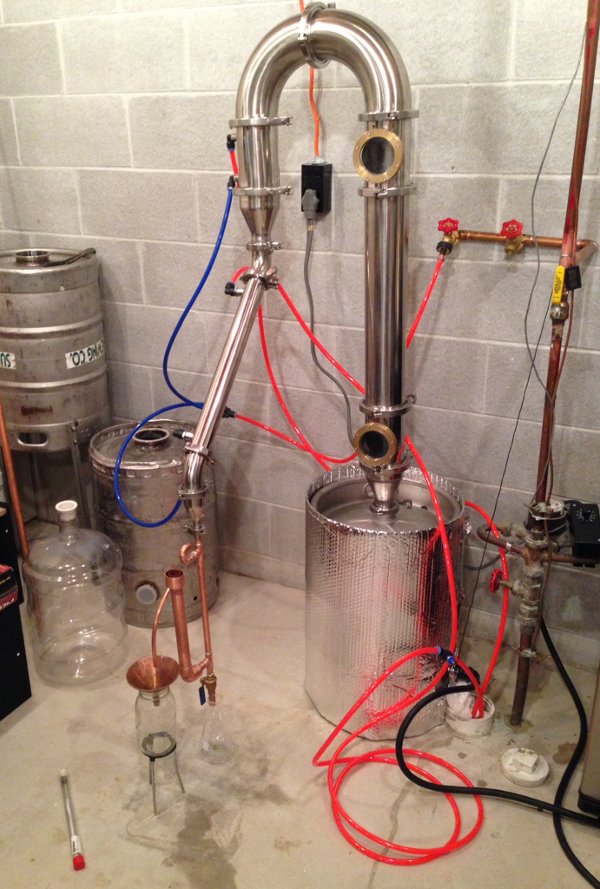Running Hot & Fast vs. Slow & Cool
Questions / thoughts are at the bottom, but first some setup:

I got my new house setup to the point where I can run the still last night and while doing some tests I ended up stripping a 10 gallon batch of TPW that had been waiting for a long time (like 5 weeks to clear).
I didn't get everything done that I wanted to prior to the run like building the new boiler, etc, but I want to do the run and free up my fermenters for the next batches.
I setup the still to strip as shown:
keg boiler with 5500 watt low density element
2" -> 4" reducer
4" Tee
4" x 20" pipe
4" Tee
4" 90 elbows (from Glacier Tanks)
4" Dephleg
4" -> 2" Reducer
2" 45 elbow
2" Shotgun condenser
2" 45
2" -> 3/4" reducer
DIY Parrot
Note that the Tees were just used to get the right height for the parrot. Eventually I'll add 2 more 4" sections of a 4" ferrule keg to gain more height for additional condensers to be used inline for more knockdown power.
Cooling water temp was about 15C from the tap, output during the run was about 25-26C
Run results:
~10 gallons of TPW
Fire up @ 10:15
First drips @ 10:47
500ml collected by 10:51 - held to discard
1l at 150 -> 140 (hot side of warm) - 10:56
1l at 140 -> 136 - 11:00
1l at 136 -> 132 - 11:04
1l at 132 -> 126 - 11:08
1l at 126 -> 120 - 11:12
1l at 120 -> 116 - 11:18
1l at 116 -> 110 - 11:23
1l at 110 -> 100 - 11:28
1l at 100 -> 84 - 11:33
1l at 84 -> 70 - 11:38
Cut power at a hot 70 proof
I ran at 5500 watts throughout the run with no issues knocking everything down, though the product did come out pretty warm (never measured). I know the proof readings at the actual temp aren't accurate, but it's all just low wines anyway.
I'm pretty happy with the results of last night, mainly with the fact that I needed less than 90 minutes to make a run. Ideally I'd put another dephlem or condenser in line with the current setup (or both) and be able to run as much as 11,000 watts for stripping runs to get this done in under an hour. That way I can run the still in little more time than my wife needs to put our daughter to bed and clean up from dinner. If it's that quick, I can run the still way more often without feeling guilty or running into time issues.
Note that the whole process is more than 90 minutes with transferring the wash and then cleaning up, but I do those on the night before and the night after to break it up and then to the let the still cool, figure 20 minutes each of those nights.
OK, that was a lot of info for the questions here:
- I recall a lot of discussion on other forums in the last few years about running fast resulting in inferior product and running to the point where the product is hot resulting in inferior product. Is there any explanation of that?
- Why is running fast bad?
- If I can knock down the vapor, what's wrong with going full out?
- Does it matter at all if I'm doing fast and hot stripping runs and then run with a bit more patience for the spirit run through my Hybrid Dash 2 (6 plate topped by 20" copper mesh packed section)?
- If I run 11,000 watts to basically negate heat up time and then run more slowly, does that have any negative effects?
Any other thoughts to speed the run or can you convince me not to?




Comments
That's a great strip rate, you have to be happy with 12l and hour from a keg.
I've never seen anything directed at tripping that i'd trust that say's it's damaging to the product in any way to run fast? Certainly spirit runs in my experience can be tailsy from running to fast or solventy from running too slow.
I'd strip as hard and as fast as you like though.
StillDragon Australia & New Zealand - Your StillDragon® Distributor for Australia & New Zealand
I agree with @punkin, for a stripping run let her rip.
What you have shown is about as perfect of a stripper as possible.
Sure, you can always add more power and more and bigger condensers but for a keg boiler (50L?) your setup looks ideal @Jung.
Also noticed that you plumbed the condenser and pre-condenser in parallel instead of series. I'm certain that over time that plumbing scheme will be debated. It certainly should have more knockdown power the way you have it plumbed but would not take advantage of the "only very warm" water exiting the product condenser.
I'm glad to see folks using pre-condensers because they help to save water. The pre-condenser breaks the vapor into a hot liquid that the main product condenser can more easily cool.
Really good stuff @Jung.